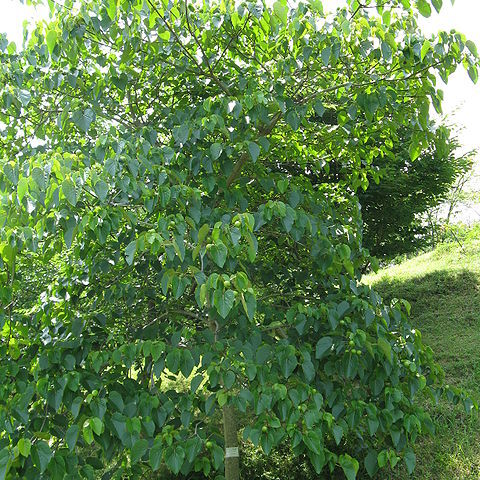Monoecious or subdioecious trees. Indumentum simple or subsimple. Leaves alternate, simple, entire or palmatilobed, petiolate, stipulate, the stipules soon deciduous. Inflorescences terminal, thyrsiform, androgynous and protogynous with a solitary terminal ♀ flower and several lateral ♂ flowers and cymules, or else the inflorescences unisexual; bracts lanceolate, the lower sometimes persistent, the upper soon deciduous. Flowers large. Male flowers: calyx closed in bud, later valvately rupturing into 2–3 lobes; petals 5, free, contorted; disc of 5 free erect glands; stamens 2-verticillate, (8–)10–14, the outer ± free or fused for a third of their length, the inner fused for over half their length, anthers introrse; pistillode 0. Female flowers: calyx, petals and disc ± as in the ♂ flowers; ovary 3(–5)-locular, with 1 ovule per locule; styles 3(–5), ± free or united at the base, bifid. Fruits large, tardily dehiscent from the base; exocarp fibrous; endocarp woody or crustaceous, 3(–5)-locular. Seeds ovoid-trigonous, ecarunculate, testa thick, woody, albumen hard; embryo straight; cotyledons broad, flat.
Trees, evergreen, perennial, monoecious; stems and foliage without latex. Indumentum of simple trichomes, glandular trichomes absent, stinging trichomes absent. Stipules entire, conspicuous, deciduous. Leaves alternate, petiolate, elobate or palmatilobed, entire, palminerved, glands 2 at lamina base. Inflorescences terminal, thyrsiform, solitary, unisexual or bisexual and androgynous, with flowers in bracteate clusters. Male flowers pedicellate; calyx lobes 2 or 3, valvate, partially connate; petals 5, imbricate, free; disc of 5 free glands; stamens 8–14, filaments biseriate, outer series fused for a third of length, inner series fused for over half of length; anthers dorsifixed, bilobate, thecae oblong and longitudinally dehiscent; pistillodes absent. Female flowers pedicellate; calyx lobes 2 or 3, valvate, shortly connate; petals 5, imbricate, free; disc absent; ovary 3–5-locular, ovules uniloculate; styles free or shortly connate at base, bifid. Fruit capsular, tri-to pentalobate, surface smooth, dehiscing basally. Seeds ovoid; testa woody; albumen hard; ecarunculate; cotyledons broad, flat.
Trees, monoecious or dioecious; indumentum of simple or T-shaped hairs, often sparse. Leaves alternate, simple; stipules caducous; petiole long, with 2 adaxial glands at apex; leaf blade entire, palmately veined. Inflorescence terminal, much branched, thyrsoid, cymules of bisexual inflorescences each with several male flowers and a terminal female flower; bracts inconspicuous. Male flowers: buds ovoid or subglobose; calyx ± spatheate, ± regularly 2-or 3-lobed; petals 5, white or reddish white to purple, base clawed; disk segments 5, subulate; stamens 8-12, in 2 series; outer filaments free, inner ones longer and connate at base. Female flowers: sepals and petals as in male; disk obscure or absent; ovary densely pubescent, 3(-8)-locular; ovules 1 per locule; styles 3-5, bifid. Fruit a drupe, large, subglobose, beaked at apex, indehiscent or slightly dehiscent at base, 3-seeded; exocarp crustaceous. Seed without caruncle; seed coat woody.
Male flowers: calyx closed in bud, valvately rupturing into 2–3 lobes; petals 5, free, contorted; disk glands 5, free, alternating with the petals; stamens 8–14, 2(3)-verticillate, the outer free or fused at the base, the inner fused for over half their length into a column, anthers subdorsifixed, introrse, longitudinally dehiscent, with a broad connective; pistillode absent.
Inflorescences terminal, thyrsiform, androgynous and protogynous with a single female flower and the rest male, or unisexual; bracts lanceolate, the lower bracts sometimes persistent, the upper soon falling.
Female flowers: calyx, petals and disk more or less as in the male flowers; ovary 3(5)-locular, with 1 ovule per loculus; styles erect, 3(5), united at the base, bifid or bipartite.
Seeds ovoid-trigonous, ecarunculate; testa thick, woody; albumen hard; embryo straight; cotyledons broad, flat.
Fruits shallowly 3(5)-lobed, tardily dehiscent; exocarp fibrous; endocarp thinly woody or crustaceous.
Leaves alternate, stipulate, long-petiolate, simple, entire or palmately lobed, palminerved.
Monoecious or subdioecious trees.
Indumentum simple or subsimple.
Stipules soon falling.
Flowers large.

